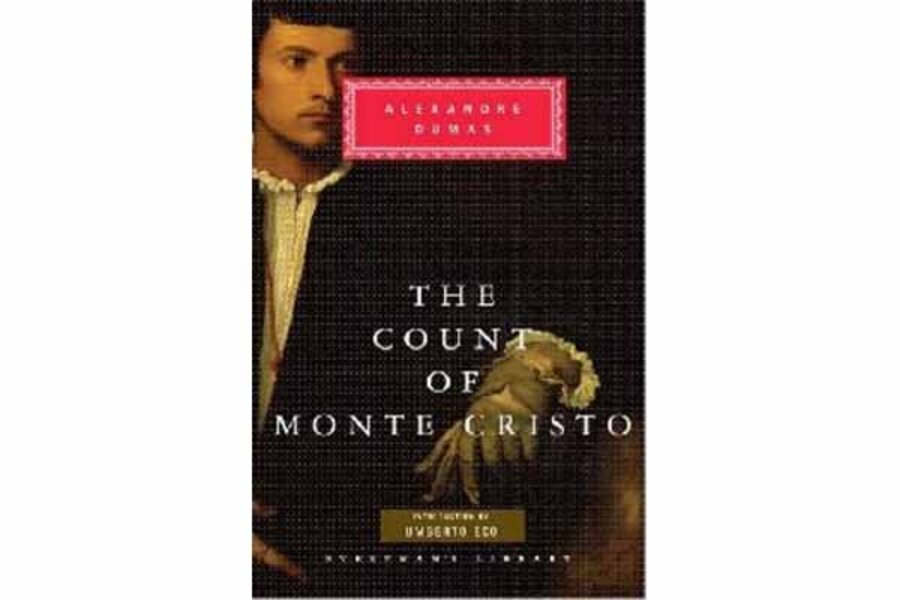Classic review: The Count of Monte Cristo
Loading...
[This review from the Monitor's archives originally ran on July 14, 2009.] The Count of Monte Cristo, Dumas’s doorstop of derring-do, demonstrates its durability yet again, this time in a newly edited version led by a perceptive essay by Italian master of letters Umberto Eco. In the name of the throes, Eco outlines all of the novel’s excesses and weaknesses but still pronounces it irresistible.
He’s right in every sense. Dumas suffers from logorrhea, induced by the simple formula that the more he wrote, the more money he made. Beyond that pecuniary circumstance, the author serialized his works, forcing endless repetition of scenes and dialogue in an attempt to ensure continuity. This newly edited version of “Monte Cristo” offers some streamlining, but it hasn’t been noticeably trimmed.
After all, any novel running close to 1,200 pages cannot be deemed overedited. So it must be said of the latest Dumas. To this reader, who has read other editions of the book several times, the Everyman’s version retains the heft and majesty of “Monte Cristo” in all of its breathtaking glory.
6 books to beat the winter blues
Dumas published the book in 1846. It is no exaggeration to say “Monte Cristo” still ranks as one of the most exciting stories imaginable, one every bit as good as anything Steven Spielberg or J.K. Rowling could ever conjure up.
Edmond Dantes, a young sailor on the cusp of being named captain of a cargo ship and preparing to marry his sweetheart, becomes the victim of a plot by envious rivals. It leads to false imprisonment of the worst kind, with young Dantes banished to the 19th-century French version of Alcatraz.
Dantes is an innocent of spectacular proportions, clueless as to who has conspired against him – and just as ignorant about how horrible his prospects for ever seeing daylight again have become.
As Eco notes, Dumas pulls off three spectacular narratives in “Monte Cristo.” He tells the story of a wronged innocent man, relates a spectacular hidden-treasure scenario, and caps the fall and rise of his hero’s fortunes with a thrilling series of vendettas allowing readers the endless satisfaction of seeing retribution delivered with violent verve.
Those are technical descriptions of what Dumas accomplishes. Better put, Edmond Dantes makes James Bond, Indiana Jones, and Jason Bourne look in the mirror and wonder why nothing interesting ever happens.
Among other things, Dantes escapes certain death after being thrown off a cliff while wrapped in a shroud, dabbles with pirates and smugglers, disguises himself as an Italian priest and a British aristocrat and, just for grins, floats easily among high society and lowlife thieves across Europe and the Far East.
Eventually Dantes morphs into the count of the Italian islet of Monte Cristo. He then commands a hidden grotto filled with otherworldly comforts and a staff of loyal servants ready to serve up Cordon Bleu cuisine, not to mention untold riches that afford him the luxury of re-creating this Neverland wherever he travels. It’s enough to make Jerry Bruckheimer wonder why his plots lag so.
And, of course, Monte Cristo is an expert shot and swordsman; navigates oceans in a custom yacht; dabbles in potions and poisons; and still manages to know the latest in fashion, opera, and financial speculations. This last carries more than a whiff of contemporary urgency: Fortunes dissolve in hours or days as schemes thinner than the paper they’re written on devolve into financial ruin, with panic and yo-yo markets driven by greed and corruption.
As much as anything, Dumas sheds a withering light on political machinations and intrigue during the time of Napoleon’s Hundred Days. Paranoia and accusations fly, with people powerful and otherwise jailed, ruined – even killed – by insinuation and negligible betrayals.
“Monte Cristo” hews to stock characters, but these stereotypes brim with life because of the extraordinary circumstances and delightful coincidences Dumas draws around them. Of course the three conspirators against Dantes in his youth become respected if tenuous aristocrats 15 years later, just as the newly christened Count of Monte Cristo begins plotting to balance the ledger.
Eco, in an unspoken nod to Mark Twain, doubts the aesthetic art of “Monte Cristo,” but salutes the novel’s narrative drive. It’s another way of saying it’s not Twain’s definition of a classic (“something everyone wants to have read but nobody wants to read.”) Instead, because it is so readable, “Monte Cristo” is still difficult to put down more than 150 years after being first published.
For all his digressions and overwriting (once Eco tips a reader off to speakers in the novel turning “pale,” it seems impossible to make it two paragraphs without seeing this and other verbal tics), Dumas delights with his insatiable appetites for digression and observation.
One of but many examples comes in a conversation between Dantes’s Italian priest and a lesser conspirator:
‘Ah!’ said the abbe, with a peculiar tone, ‘he is happy.’
‘Happy! Who can answer for that? Happiness or unhappiness is the secret known but to oneself, and walls have ears, but no tongue....’
Does anyone talk like this? Doubtful, but no matter. Dumas, much like Edmond Dantes, can get away with just about anything.
Erik Spanberg is a freelance writer in Charlotte, N.C.






